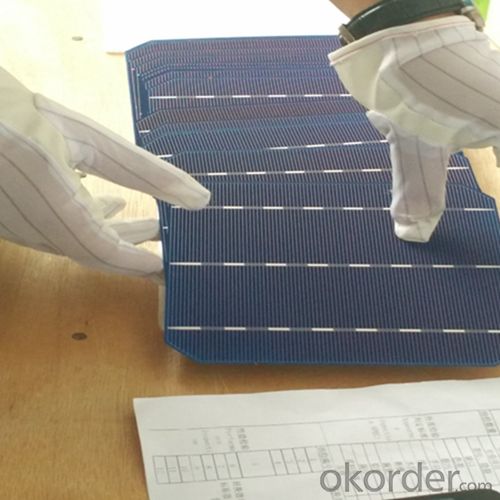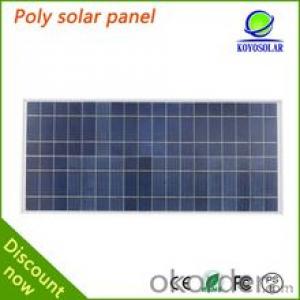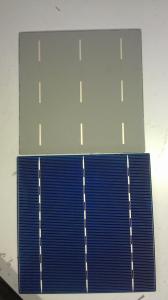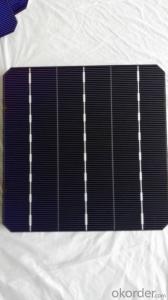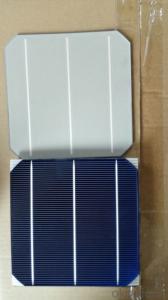Plasmonic Wholesale Poly Solar Cell 156mm x 156mm from China
- Loading Port:
- Shanghai
- Payment Terms:
- TT or LC
- Min Order Qty:
- 6500 watt
- Supply Capability:
- 6000000 watt/month
OKorder Service Pledge
OKorder Financial Service
You Might Also Like
The operation of a photovoltaic (PV) cell requires 3 basic attributes:
The absorption of light, generating either electron-hole pairs or excitons.
The separation of charge carriers of opposite types.
The separate extraction of those carriers to an external circuit.
In contrast, a solar thermal collector supplies heat by absorbing sunlight, for the purpose of either direct heating or indirect electrical power generation from heat. A "photoelectrolytic cell" (photoelectrochemical cell), on the other hand, refers either to a type of photovoltaic cell (like that developed by Edmond Becquerel and modern dye-sensitized solar cells), or to a device that splits water directly into hydrogen and oxygen using only solar illumination.Characteristic of Mono 156X156MM2 Solar Cells
You are gaining energy independence - add battery backup power for even greater energy security
The cost of electricity is only going to rise – insure against that rising cost
Adaptive cells change their absorption/reflection characteristics depending to respond to environmental conditions. An adaptive material responds to the intensity and angle of incident light. At the part of the cell where the light is most intense, the cell surface changes from reflective to adaptive, allowing the light to penetrate the cell. The other parts of the cell remain reflective increasing the retention of the absorbed light within the cell.[67]
In 2014 a system that combined an adaptive surface with a glass substrate that redirect the absorbed to a light absorber on the edges of the sheet. The system also included an array of fixed lenses/mirrors to concentrate light onto the adaptive surface. As the day continues, the concentrated light moves along the surface of the cell. That surface switches from reflective to adaptive when the light is most concentrated and back to reflective after the light moves along
Mechanical data and design
Format | 156mm x 156mm±0.5mm |
Thickness | 210μm±40μm |
Front(-) | 1.5mm bus bar (silver),blue anti-reflection coating (silicon nitride) |
Back (+) | 2.5mm wide soldering pads (sliver) back surface field (aluminium) |
Temperature Coefficient of Cells
Voc. Temp.coef.%/K | -0.35% |
Isc. Temp.coef .%/K | +0.024%/K |
Pm.Temp.coef. %/K | -0.47%/K |
Electrical Characteristic
Effiency(%) | Pmpp(W) | Umpp(V) | Impp(A) | Uoc(V) | Isc(A) | FF(%) |
18.35 | 4.384 | 0.526 | 8.333 | 0.63 | 8.877 | 78.39% |
18.20 | 4.349 | 0.526 | 8.263 | 0.63 | 8.789 | 78.54% |
18.05 | 4.313 | 0.525 | 8.216 | 0.63 | 8.741 | 78.32% |
17.90 | 4.277 | 0.524 | 8.161 | 0.625 | 8.713 | 78.04% |
17.75 | 4.241 | 0.523 | 8.116 | 0.625 | 8.678 | 77.70% |
17.60 | 4.206 | 0.521 | 8.073 | 0.625 | 8.657 | 77.36% |
17.45 | 4.170 | 0.519 | 8.039 | 0.625 | 8.633 | 76.92% |
17.30 | 4.134 | 0.517 | 8.004 | 0.625 | 8.622 | 76.59% |
17.15 | 4.096 | 0.516 | 7.938 | 0.625 | 8.537 | 76.80% |
17.00 | 4.062 | 0.512 | 7.933 | 0.625 | 8.531 | 76.18% |
16.75 | 4.002 | 0.511 | 7.828 | 0.625 | 8.499 | 75.34% |
16.50 | 3.940 | 0.510 | 7.731 | 0.625 | 8.484 | 74.36% |




 FAQ
FAQ
Q: What price for each watt?
A: It depends on the quantity, delivery date and payment terms, generally Large Quantity and Low Price
Q: What is your size for each module? Can you tell me the Parameter of your module?
A: We have different series of panels in different output, both c-Si and a-Si. Please take the specification sheet for your reference.
Q: What is your size for each module? Can you tell me the Parameter of your module?
A: We have different series of panels in different output, both c-Si and a-Si. Please take the specification sheet for your reference.
Poly solar cell 156mm manufacturing process
Cell sorting - Single Welding - string jointing - splicing (the string is welded battery slice positioning, stitching together) - intermediate test (intermediate test points: Infrared testing and visual inspection) - laminated - cutting edge - layer after appearance - after layer infrared - mounted box (usually aluminum frame) - mounted terminal box - cleaning - tests (this link also points infrared testing and visual inspection of the component level determination.) - Packaging.
(1) poly solar cell 156mm test
Because of the randomness of the solar cell manufacturing conditions, produced by the battery performance is different, so in order to effectively identical or similar battery together, it should be classified according to its performance parameters; battery test through the test cell output parameters (current and voltage) of the size of its classification. In order to improve the utilization of the battery, a battery pack made of acceptable quality.
(2) poly solar cell 156mm welding positive
Main gate line, convergence with soldered to the battery positive (negative), the convergence zone for the tinned copper strip, we use a welding machine can weld with a multi-point spot welding in the form of the main gate line. Welding heat source is an infrared lamp (using infrared thermal effect). The length of the ribbon is about 2 times the battery side length. More welding belt behind the back of the welding electrode is connected to the back of the back of the battery slice.
(3) poly solar cell 156mm in series
On the back of the battery is soldered together in series to form a module string, we are currently used process is manual, locate the battery depends mainly on a membrane with plate placement battery film grooves, groove size and battery size phase corresponding to the location of tank has been designed well, different specifications of the components use a different template, the operator use a soldering iron and solder wire will "in front of the battery," the positive electrode (anode) is welded to the "behind the battery" on the back electrode (cathode) this in turn connected in series with the positive and negative components in a string of welding wire.
- Q: How do solar cells handle partial shading?
- Solar cells handle partial shading by using bypass diodes. These diodes allow the current to bypass the shaded area, ensuring that the rest of the solar cell continues to function efficiently. By redirecting the current, the solar cells can still generate power even if some parts are shaded, minimizing the impact of partial shading on overall performance.
- Q: What is the impact of solar cells on reducing noise pollution from power generation?
- Solar cells have a positive impact on reducing noise pollution from power generation as they operate silently, without the need for noisy machinery or moving parts.
- Q: How to make solar cells in a scientific way?
- You can make it but you won't get too much energy out of that.
- Q: Can solar cells be used in satellite or space exploration missions?
- Yes, solar cells can be used in satellite or space exploration missions. In fact, they are extensively utilized in these missions to provide power to spacecraft and satellites due to their ability to convert sunlight into electricity efficiently.
- Q: What is the best way to deal with surplus solar cells abandoned after burning?
- It has to be treated in a special way, which is chemically separated, otherwise, the surplus can not really be utilized again.
- Q: Can solar cells be used for powering navigation buoys?
- Yes, solar cells can be used for powering navigation buoys. Solar cells are an environmentally friendly and reliable source of renewable energy that can efficiently convert sunlight into electricity. By harnessing solar power, navigation buoys can operate independently without the need for traditional power sources like batteries or grid connections. This makes solar cells a cost-effective and sustainable solution for powering navigation buoys in remote or offshore locations.
- Q: How do solar cells perform in areas with high levels of industrial emissions?
- Solar cells can still perform effectively in areas with high levels of industrial emissions. While industrial emissions can potentially reduce the overall performance of solar cells due to air pollution and particulate matter, the impact can vary depending on the specific pollutants and their concentration. Regular cleaning and maintenance of the solar panels can help mitigate any negative effects. Additionally, advancements in solar cell technology, such as anti-reflective coatings and improved efficiency, can enhance their performance even in challenging environments.
- Q: How do solar cells impact job creation?
- Solar cells impact job creation by creating a demand for skilled workers in the solar industry. As the adoption of solar energy grows, more jobs are created in manufacturing, installation, maintenance, and research and development of solar cells. This not only helps stimulate the economy but also provides employment opportunities for individuals in a rapidly expanding sector.
- Q: How do monocrystalline solar cells differ from polycrystalline solar cells?
- Monocrystalline solar cells are made from a single crystal structure, resulting in a uniform dark color and higher efficiency. On the other hand, polycrystalline solar cells are made from multiple crystal structures, giving them a speckled appearance and slightly lower efficiency.
- Q: What is the impact of snow accumulation on solar cell performance?
- Snow accumulation on solar cells can have a negative impact on their performance. The presence of snow on the surface of solar panels can block sunlight from reaching the cells, reducing their ability to generate electricity. Additionally, snow can create a barrier that prevents proper heat dissipation, which can lead to overheating and potential damage to the cells. Regular snow removal or tilt angles that facilitate snow shedding can help mitigate these effects and ensure optimal solar cell performance.
Send your message to us
Plasmonic Wholesale Poly Solar Cell 156mm x 156mm from China
- Loading Port:
- Shanghai
- Payment Terms:
- TT or LC
- Min Order Qty:
- 6500 watt
- Supply Capability:
- 6000000 watt/month
OKorder Service Pledge
OKorder Financial Service
Similar products
Hot products
Hot Searches
Related keywords







